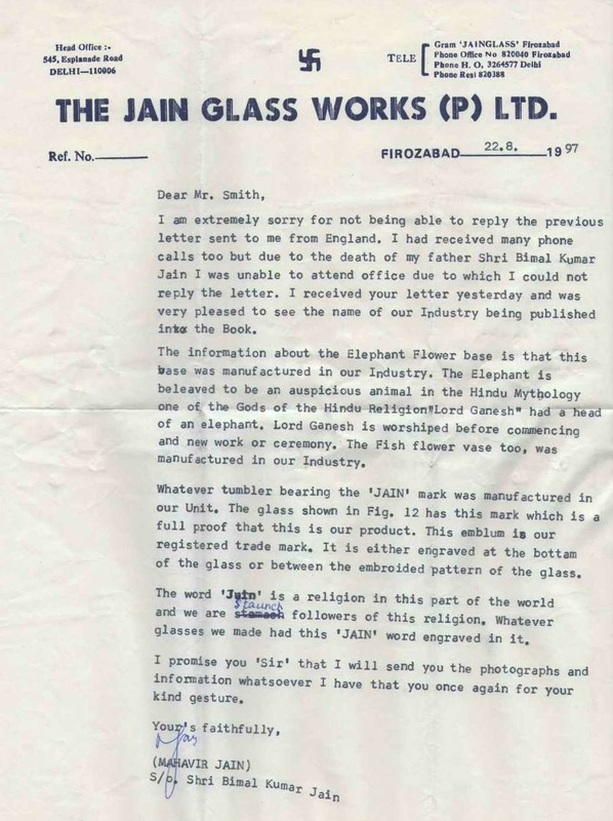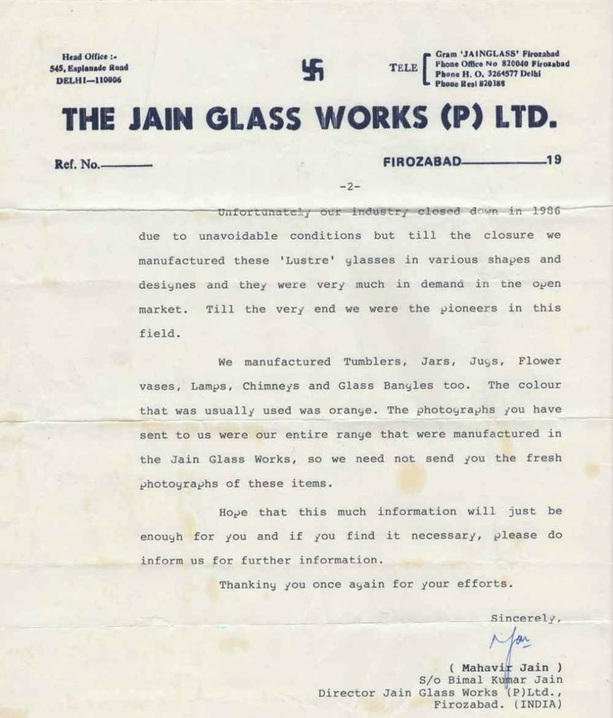Carnival Glass from India - The Story Behind The Glass
|
By Glen & Stephen Thistlewood, with special thanks to (the late) Bob Smith, in Boston, for his outstanding pioneering research, and to Vikram Bachhawat for sharing his invaluable research into Carnival Glass makers in India.
|
November 2015 (updating information published since 1997)
|
Left to right: Diamante Stars vase (in an aqua colour often referred to as "Jain blue"), Shalimar tumbler, Monsoon tumbler and
Diamante Rain vase (all three in marigold). All four items were probably made by Advance Glass Works in India.
Diamante Rain vase (all three in marigold). All four items were probably made by Advance Glass Works in India.
|
Back in the late 1990s, we worked extensively with Bob Smith, researching and documenting Carnival Glass – pushing the boundaries of knowledge into previously unknown areas, with India being an especially fascinating case. Through Bob, we were able to gain the first definite proof that Carnival was made there. Subsequently, we were contacted by Vikram Bachhawat who provided further invaluable information and his research into Carnival Glass made in India. The Jain logo on the left is moulded on the base of a marigold “Embroidered Panels and Flowers” tumbler. |
|
The earliest glass making in India was probably around 3000 years ago, but glass didn’t become common in India until around the third century BC, when there is evidence of the production of beads and arm rings. Industrial production began in the early 1900s and today India has an extensive glassmaking industry, much of it centred around Firozabad, which lies just to the east of the wonderful Taj Mahal at Agra. The earliest glass furnaces here were all fired by wood, but after World War I, the Indian Government fixed specially low prices on the transport of coal to meet the needs of the newly established glassworks. Further help came in 1927, when duties were placed on imported foreign glass goods in order to protect the domestic Indian glass industry. Between the two World Wars several attempts were made to modernise production. Glass technicians and craftsmen from Europe (in particular from the former Czechoslovakia, which had very strong trading links with India) were brought in to advise and train within the growing Indian glass industry. |
Left to right: Hand Vase (Right Hand), Fish Vase, partially frosted,
Elephant Vase. The Fish and Elephant Vases are marked "JAIN". The Hand Vase is attributed to Jain, but is unmarked. |
|
The Jain Glass Works (P) Ltd. In the wide floodplain of the sacred River Ganges in northern India lies the industrial town of Firozabad, the country’s main location for the manufacture of glass articles. Bangles, beads, drinking glasses and general household goods were produced. There, in Firozabad, at the factory of the Jain Glass Works (P) Ltd., they made Carnival Glass - a fact confirmed by a director of the company, Mahavir Jain. The Jain Glass Works was founded by the late Shri Chhadamilal Jain in 1928. It was one of the first companies to bring the (then) latest technology in glass manufacturing and decoration into India. Iridised Carnival glass was first made at the Jain factory in 1935. The founder’s son, the late Bimal Kumar Jain, added his own style of manufacturing the glass and called it “Lustre Glass.” The company name JAIN can sometimes be found moulded or acid etched into the glass. The swastika logo is also seen on some items of Jain Carnival, in particular, the Elephant Vase. In 1986, the Jain Glass Works closed down due to “unavoidable conditions” according to Mahavir Jain. Vases and drinking glasses were the main items that Jain produced in Carnival Glass. The designs and styles are quite wonderful and exotic, reflecting the rich culture and history of the Indian sub-continent. We show many of them in our India Carnival Glass Tumblers Gallery. There is much more information on Carnival Glass from India on our India Homepage. |
The Letters!
Here, for the first time, courtesy of Bob Smith, we are able to share the letters from Mahavir Jain in India that confirm and inform on the production of Carnival at the Jain Glass Works.
As seen on their factory letterhead, the company’s logo is a sathya (swastika) which, in India, is an auspicious, traditional and sacred symbol. This emblem is a very old, auspicious good luck symbol, almost certainly first used in India in the first and second centuries. In Sanskrit it is Svasti, meaning fortune or happiness.
The “book” that is referred to in the second letter (August 1997) is our first book “Carnival Glass The Magic and The Mystery” (1997).
Letter Dated 22 August 1997
Letter Dated 31 January 1997
Interested to find out more about Carnival Glass from India? It's all on our India Homepage.
Read more of The Stories Behind The Glass in Carnival Glass Times







